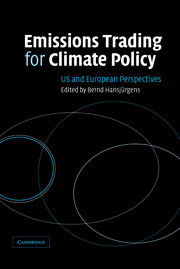Book contents
- Frontmatter
- Contents
- List of figures
- List of tables
- List of contributors
- Preface
- List of abbreviations
- 1 Introduction
- Part 1 Regulatory instruments for climate policy: theoretical aspects
- Part 2 The US approach to pollution control: lessons for climate policy
- Part 3 European policies to control greenhouse gases: the EU directive on emissions trading
- 9 Regulation or coordination: European climate policy between Scylla and Charybdis
- 10 Lobbying and CO2 trade in the EU
- 11 Greenhouse gas emissions trading in the EU: building the world's largest cap-and-trade scheme
- 12 Legal aspects of the European Emissions Trading Scheme
- 13 Emissions trading schemes in Europe: linking the EU Emissions Trading Scheme with national programs
- 14 Concluding observations
- Index
- References
12 - Legal aspects of the European Emissions Trading Scheme
Published online by Cambridge University Press: 22 September 2009
- Frontmatter
- Contents
- List of figures
- List of tables
- List of contributors
- Preface
- List of abbreviations
- 1 Introduction
- Part 1 Regulatory instruments for climate policy: theoretical aspects
- Part 2 The US approach to pollution control: lessons for climate policy
- Part 3 European policies to control greenhouse gases: the EU directive on emissions trading
- 9 Regulation or coordination: European climate policy between Scylla and Charybdis
- 10 Lobbying and CO2 trade in the EU
- 11 Greenhouse gas emissions trading in the EU: building the world's largest cap-and-trade scheme
- 12 Legal aspects of the European Emissions Trading Scheme
- 13 Emissions trading schemes in Europe: linking the EU Emissions Trading Scheme with national programs
- 14 Concluding observations
- Index
- References
Summary
In October 2003, the Directive “establishing a scheme for greenhouse gas emission allowance trading within the Community” came into force. After long debates, especially among economists, this represents a first step towards the implementation of a new instrument of environmental policy. Following the examples of member states such as Denmark, the Netherlands, and the United Kingdom, which had already introduced domestic trading schemes, emissions trading will form one of the instruments of European climate policy.
The Directive establishes a specific legal framework for emissions trading. This will lead to a fundamental change in perspective in the debate, from the theoretical advantages and disadvantages of this environmental policy instrument toward concrete and practical questions of implementation and application.
This chapter discusses the legal framework set up by European or national law for the Directive and its implementation in the domestic legal systems of the member states. A comprehensive survey of the legal questions is beyond the scope of this chapter. In the interest of brevity, it focuses on four major issues:
the leeway of European law-making bodies in relation to the national legislator;
compatibility of the emissions trading system with public international law, especially in the field of trade and climate protection;
legal limitations and guiding principles affecting the design of the emissions trading system (especially higher-ranking law); and
compatibility with other environmental policy instruments.
- Type
- Chapter
- Information
- Emissions Trading for Climate PolicyUS and European Perspectives, pp. 177 - 198Publisher: Cambridge University PressPrint publication year: 2005



